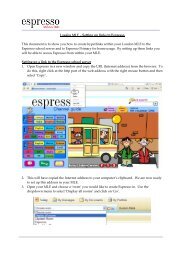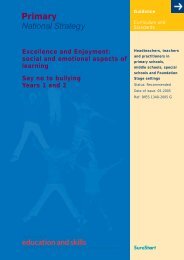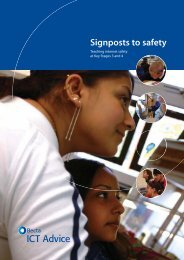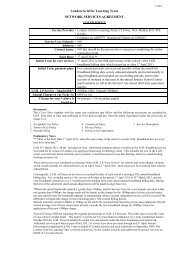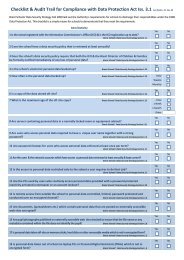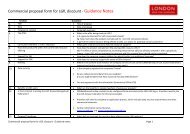Developing the home-school relationship using digital ... - Futurelab
Developing the home-school relationship using digital ... - Futurelab
Developing the home-school relationship using digital ... - Futurelab
- No tags were found...
Create successful ePaper yourself
Turn your PDF publications into a flip-book with our unique Google optimized e-Paper software.
STRATEGIC CONSIDERATIONS3.6 POSITIVE FEEDBACK33.6 POSITIVE FEEDBACKCatch <strong>the</strong>m being goodTeachers, parents and children felt thatopportunities for positive feedback wereoften overlooked, and hoped that <strong>digital</strong>communication strategies would facilitatemore of this.Much communication from <strong>school</strong> to<strong>home</strong> tends to focus on negative aspects:communication is prompted when <strong>the</strong>re isa concern around children’s behaviour orprogress. The data that is collected and sharedaround progress, achievement, behaviour hasa tendency to highlight problems. A pressureon time also means that communication aboutproblems tends to be prioritised as more urgentthan positive feedback. However, <strong>using</strong> <strong>digital</strong>technologies might offer easier opportunitiesto send <strong>home</strong> positive messages aboutchildren’s <strong>school</strong> life.Sending positive feedback to both childrenand <strong>the</strong>ir parents can be more effective insupporting children’s development than aconstant stream of negative information. Whenparents only ever hear negative informationabout <strong>the</strong>ir child, and a child only ever hearsnegative feedback about <strong>the</strong>mselves, it cancome to seem impossible that <strong>the</strong>y can doanything to change <strong>the</strong> situation, and lead tofeelings of powerlessness and disengagementfrom education. Positive feedback howevercan show children and <strong>the</strong>ir parents that it ispossible for <strong>the</strong>m to be successful at <strong>school</strong>,and give <strong>the</strong>m something to build on in orderto develop fur<strong>the</strong>r. Reinforcing praise at <strong>school</strong>with praise from parents at <strong>home</strong> can builda virtuous circle that builds children’s selfesteem,showing <strong>the</strong>ir efforts are recognisedand valued by both teachers and parents, andhelps <strong>the</strong>m envisage positive future scenarios 80 .Digital technologies could support <strong>the</strong>exchange of positive feedback in a number ofways. Showing examples of children’s goodwork, whe<strong>the</strong>r that be written documents,photos and artworks, music and videorecordings, allows o<strong>the</strong>rs to see exactlywhat <strong>the</strong> praise is for, and allows teachersto model how to give praise for children’sefforts and positive learning behaviour aswell as achievement.“[Positive feedback] is just really nice,cos [my son seems] very confident bu<strong>the</strong>’s got really low self esteem. So whenhe gets things like that you know it’sreally like ‘that’s brill, well done’. And youknow it might just build him up a little bit,it just gives him a bit of, you know, puffdoesn’t it?” (Parent)Parents are often pleasantly surprised by <strong>the</strong>quality of <strong>the</strong> work children complete in <strong>school</strong>.Giving positive feedback is often overlookedas it is time consuming and not always a highpriority. Digital technologies could providereminders to look for opportunities to providepositive feedback and can make <strong>the</strong> process ofsending feedback quicker and easier. Parentscan receive feedback during <strong>the</strong> day by text oremail, so that <strong>the</strong>y know by <strong>the</strong> time childrencome <strong>home</strong> from <strong>school</strong>. Positive feedbackcould also be automatically recorded on achild’s profile, so <strong>the</strong>y can look back at <strong>the</strong>irachievements over time.Positive feedback from outside <strong>the</strong> classroomPositive feedback should take account of <strong>the</strong>small efforts that may not usually be remarkedupon and non-academic achievements, as wellas <strong>the</strong>ir achievements within class. Children’smembership of <strong>the</strong> <strong>school</strong> council, <strong>the</strong>irparticipation and achievements in <strong>school</strong> clubs,<strong>the</strong>ir contributions to <strong>the</strong> life of <strong>the</strong> <strong>school</strong> canall be matters for positive feedback to bothchild and parents.Positive feedback can also travel from <strong>the</strong><strong>home</strong> to <strong>the</strong> <strong>school</strong>. While children are oftenembarrassed by public praise, and may notwant to share some aspects of out-of-<strong>school</strong>life, having <strong>the</strong>ir out-of-<strong>school</strong> achievementsacknowledged within <strong>school</strong> allows forchildren to see that <strong>school</strong> cares about <strong>the</strong>irlearning, development and success in abroader context, not just in terms of <strong>the</strong>ir examresults, and can allow teachers and childrento make connections between <strong>the</strong>ir skills andachievements outside <strong>school</strong> and those neededto succeed within <strong>school</strong>.4880. Chesterton College in Cambridge communicates with parents via text message, applying a policy that for every negative messagesent, <strong>the</strong>y will send at least three positive messages.




